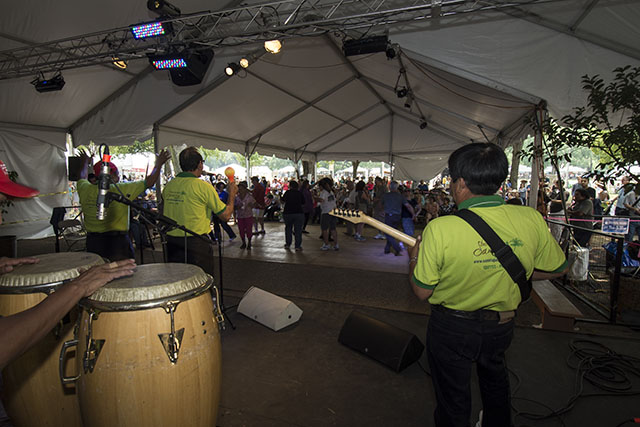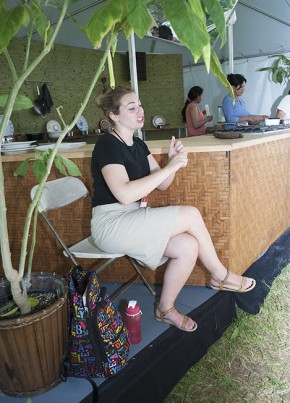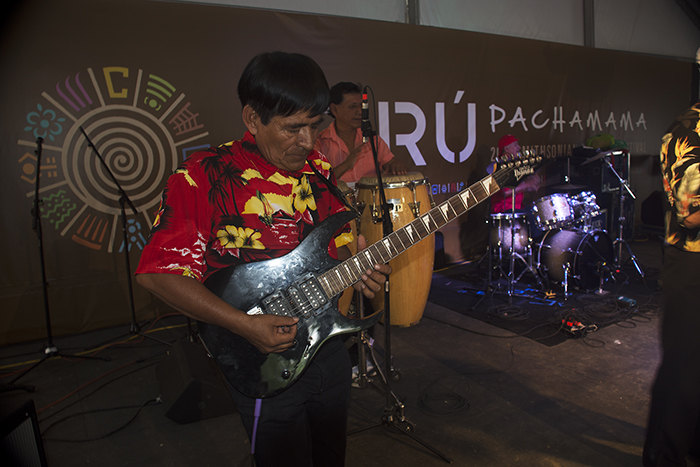Wembler’s a la Huancaína: The Confluence of Smellscapes and Soundscapes

As an aspiring musicologist participating in the Smithsonian’s Latino Museum Studies Program, I was asked to write about my experience at the 2015 Folklife Festival. Like a good student, I challenged myself to rethink the traditional approach to writing about music.
It was difficult to think of something new—I won’t lie. As I walked around the Festival, my legs almost took on a life of their own, forcing me toward the Afro-Peruvian Music and Dance tent, where the sound of the resonating cajónes intermingled with intricate guitar figurations and the powerful yet warm voices of the Ballumbrosio family.
But I was still confounded. I could not come up with an original idea. So I took a deep breath, and like a gift from Pachamama herself, the smell of pollo a la brasa (rotisserie chicken) coming from the food tents made its way to me, entering my nostrils and invading my pores.
“Aha!” I said to myself.
“Bingo!” I replied.
“I have to write about food from a musicological perspective!”
“Should I talk about the parallelisms between the culinary arts and music?” I asked.
“They both work on a temporal continuum and depend on specialized skills and rhythm, not to mention the performative aspect of them.”
“But no, no,” I shook my head. “Vamos, Daniel! That sounds way too forced. You are not writing a dissertation here.”

I knew the Festival had organized cooking presentations showcasing Peru’s “foodways,” so I headed there in search of gastronomic inspiration—or should I say aspiration? After all, as the presenter informed me, visitors were not allowed to try the foods prepared due to health regulations, so we had to rely on the smells, the sights, and, as I will explain shortly, the sounds.
El Fogón Kitchen was packed with people listening attentively to Blanca and Katya Canto, two sisters from Huancayo, a region in the highlands of Peru. The sisters, through the presenter/translator and the sign language interpreter, were showing visitors how to make papas a la huancaína, a traditional potato dish from this region and a staple of Peruvian cuisine.
All of a sudden, an explosion of sounds started competing for my attention: a punctuated guitar riff came to the foreground, one that seemed to emulate a blend of Turkish and Italian sounds (I assumed at the time pulled from the bag of Orientalized “exotica”), grooving bass lines, and a very familiar rhythm that a Colombian native like myself cannot ignore: the sound of cumbia.
This rhythm was coming from the tent next door: La Juerga Stage. It was Los Wembler’s de Iquitos, famous for their unique take on cumbia, the cumbia amazónica, as they call it. I took a step back, and another, slowly walking backward toward that tent, losing myself in the moment.
I found myself at the middle of both tents, looking over at the Q’eswachaka, the Inka rope bridge that connected us all during the two weeks on the National Mall. It was a confluence of smellscapes, soundscapes, multiple languages, multiple accents, multiple regions represented, a multiplicity of audience members that change the dynamic of the place—an inimitable microcosm of culture. The smells articulated the music, and the music the smells. I was not just experiencing the music of Los Wembler’s, or watching Blanca and Katya cook. It was an amalgam of both. I was experiencing Wembler’s a la huancaína. What a yummy aural tidbit.

P.S.: The smell of the pollo a la brasa was still there.
Daniel Castro Pantoja, a native of Colombia, is a Smithsonian Latino Museum Studies Fellow working at the Center for Folklife and Culture Heritage. He is a classical guitar player and currently a Ph.D. candidate in musicology at the University of California, Riverside.

